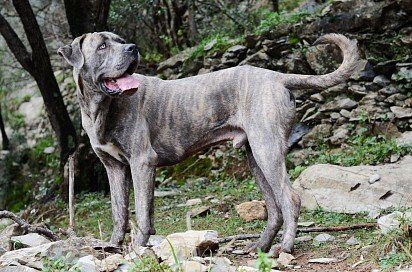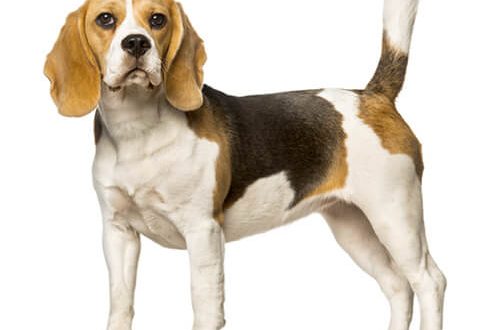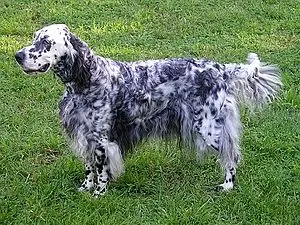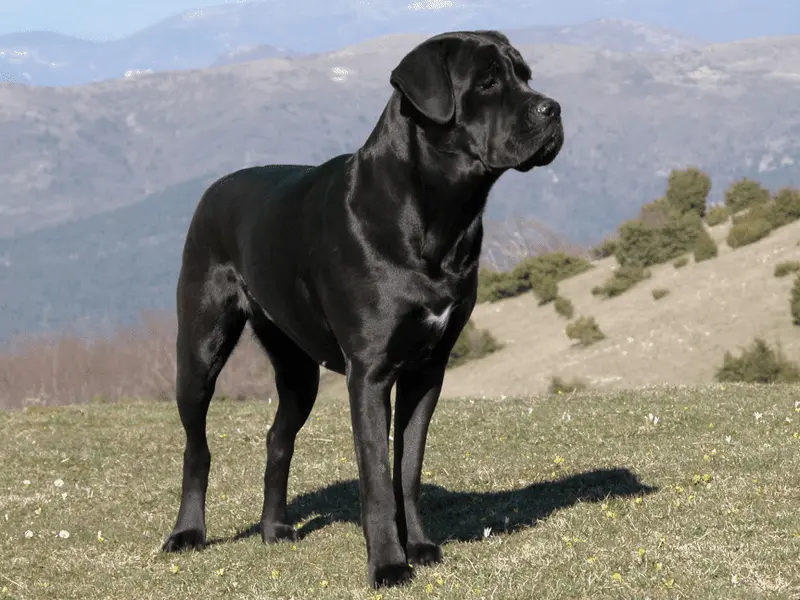
Cane Corso
Other names: Italian Cane Corso , Italian Mastiff
Cane Corso is a large breed, a descendant of the fighting dogs of ancient Rome. For centuries, these smart and obedient dogs have served their masters, guarding their homes, helping in the hunt and in the field.
Contents
- Characteristics of Cane Corso
- Basic moments
- History of the Cane Corso
- Video: Cane Corso
- Features of the Cane Corso
- Appearance and special features of the breed
- Photos cane corso
- The nature of the Cane Corso
- Training and education
- Care and maintenance
- Care and maintenance
- Health and disease of the Cane Corso
- How to choose a puppy
- Pictures of Cane Corso puppies
- How much does a Cane Corso cost?
Characteristics of Cane Corso
| Country of origin | Italy |
| The size | large |
| Growth | from 56 to 71 cm at the withers |
| Weight | from 36 to 63.5 kg |
| Age | 9–12 years old |
| FCI breed group | Pinschers and Schnauzers, Molossians, Mountain Dogs and Swiss Cattle Dogs |
Basic moments
- This dog has excellent guard qualities. The territory inhabited by the owner and members of his family, he considers his space and guards with special care.
- The Cane Corso is not aggressive by nature, but if uninvited guests show up, they will certainly feel the harsh disposition of the “Italian”.
- Representatives of the breed are strong and hardy, distinguished by intelligence and quick wits, they need constant physical and mental activity.
- In a pack, the Cane Corso shows dominant character traits, trying to lead. Some dog power can be difficult for inexperienced owners, so if you first decide to make a four-legged friend, start with a representative of a different breed.
- Cane Corso can be aggressive towards other dogs and animals, and to keep such emotions in check, the socialization of puppies must be carried out from a very early age.
- Outwardly, they look imposing and unhurried, but such an impression is deceptive. Like real “temperamental Italians”, they willingly join games, like to run and, in general, spend time actively.
- They get along well with children, becoming a reliable nanny for them. This is how the genes of distant ancestors make themselves felt – shepherd dogs, for which the owner and his family, including domestic animals, were objects of control.
- Cane Corso is characterized by kindness and attentiveness, they are affectionate with the owner and require reciprocity.
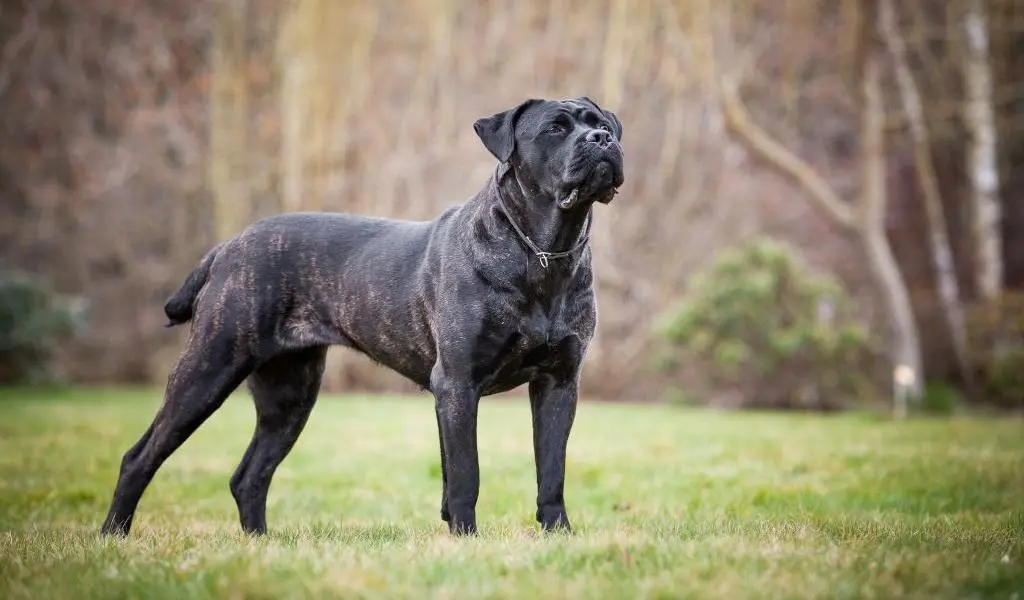
Modern Cane Corso are the descendants of gladiator dogs, they exude natural strength and grandeur. In appearance, they are harsh, they can even inspire fear, but in fact they become true friends for their owners and remain so throughout their lives. Being the fourteenth breed bred in Italy, the Cane Corso is the pride and national treasure of this country. In the nature of the dogs, the dedication of the shepherd and the courage of the fighting breeds were surprisingly intertwined, and the lively temperament of the Italians themselves was also reflected.
Cane Corso have sensitivity and intuition, they are ready to protect the owner and his family at any time and in any situation, which makes them unsurpassed guards. If a dog of this breed lives in your house, there is no need for alarm systems. They will not meet a thief who has entered the house with aggression, which is how they differ from other guard dogs, but the robber will very much regret meeting a native of the sunny Apennines. The aggressive reaction of the Cane Corso is left as a last resort, when it feels that a real threat looms over the owner and his property.
History of the Cane Corso
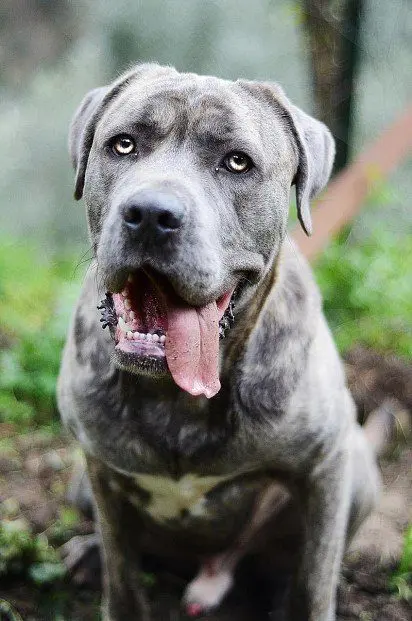
Cane Corso has a long and glorious history spanning many centuries. Their most distant ancestors were the Tibetan Great Danes of antiquity. In those harsh times, when it was necessary to defend against many enemies and wild animals, such dogs were especially valued. Genuine respect and even some reverence, these dogs cause today.
It is known that the first ancestor of modern “Italians” on the territory of modern Eurasia appeared 1 thousand years before our era. It was an aggressive Tibetan dog, which was presented to the Chinese emperor, who appreciated in him such a skill as the ability to catch people. Since that time, they quickly began to spread across the mainland, becoming the ancestors of some other breeds. New dogs were bred for very specific purposes. In the same Roman Empire, they were used for dog fights, in military campaigns and, of course, as guards.
The first written references to giant Corso dogs date back to the 14th-15th centuries. The documents discovered by historians say that they participated in hunting and persecution. In some areas, these dogs were used for grazing and guarding livestock. As for the official history of the breed, it is usually conducted from the heyday of the Roman Empire. Archaeological monuments with multiple images of these majestic dogs have survived to this day. Corso accompanied their masters on military campaigns, looked after the slaves and guarded entire palace complexes. After the fall of Ancient Rome, dogs began to be crossed with Celtic greyhounds, thereby pouring “new blood” into the breed. At the same time, they began to be used more not as fighting dogs, but for hunting, for protecting farmland and driving cattle. All this went on for a long time,
The performance of a variety of tasks by dogs made the breed versatile, which remains unchanged today. Since the Cane Corso has always been highly valued, the quality of their gene pool was carefully monitored. However, despite this, sad pages in the history of the breed could not be avoided. During the Second World War, the Cane Corso, like many other breeds, was on the verge of extinction. These giants were actively used on the front line, which, coupled with malnutrition, and often hunger, crippled the breed.
But the Cane Corso did not disappear, and for this humanity should be grateful to Giovanni Bonatti Nizzoli, who persevered and made titanic efforts to revive these proud, intelligent and majestic dogs. Invaluable help was provided to him by like-minded people, who in 1983 gathered all over Italy all purebred Cane Corso, preserved by some miracle. Four years later, the breed standard appeared – the first, approved at the official level. This document gave an accurate description of the dogs and emphasized the features that distinguished the Corso from other descendants of the mastiffs. And although the breed received a breeding registration only in 1994, before this event, more than 500 producers and several hundred puppies achieved recognition from experts and positive assessments from their side. All this gave the green light to the development and spread of the Cane Corso: the number of dogs began to grow and in a short time exceeded 3,000 individuals. At the international exhibition, held in 1996, the representative of the revived Italian breed became the winner.
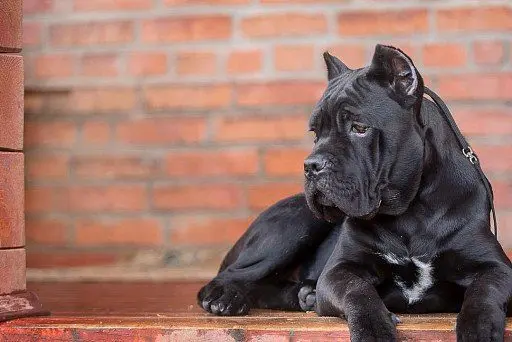
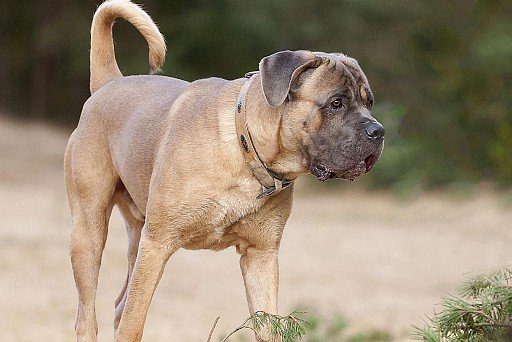
Video: Cane Corso
Features of the Cane Corso
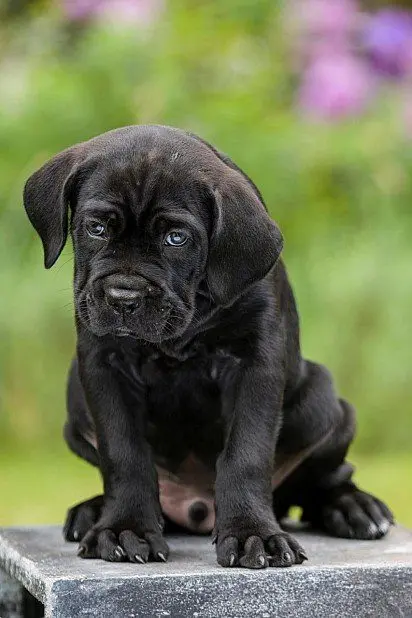
Security qualities are inherent in the Cane Corso at the genetic level, so they perform this function even without special training. The dog will protect the owner, members of his family, as well as the entire local area. With pets, this giant gets along well, even with those who are not too happy about his appearance in the house. His “friends” can have not only other dogs, including small breeds, but also cats and even birds.
Balance in these dogs is in the blood. Seeing that the guest is friendly with the owner, the “Italian” will remain calm. He will not become active if he feels a hidden threat, but will make it clear that the situation is under his control. The dog attacks only in two cases: if direct aggression is shown towards him or if he receives the appropriate command from the owner.
The Corso are especially careful with the younger members of the family, this has gone back to the time when they wandered with the flocks and developed the instinct to protect everyone who is smaller and weaker. These big dogs will never offend a child, even someone else’s, but, on the contrary, will take care of him with almost maternal zeal. Children reciprocate these dogs and often involve them in their games, such as doctors and hairdressers. It is impossible to watch without tenderness and laughter how a little crumb “treats” a dog or tries to do his hair, and Corso humbly endures. True, at the very beginning he will try to slip away from the little “doctor”, but if he fails, then he resignedly demolishes all the “procedures”. During games, the Cane Corso may accidentally, completely without malicious intent, lightly push the child. If you are worried that another such push may lead to a fall of the baby, then command the dog to “Sit!” or “Lie down!”, And she will definitely do what is required, and the first time.
Appearance and special features of the breed
Cane Corso or Italian Mastiff is a large dog with prominent muscles. The body is characterized by the so-called stretched format, when the length is greater than the height at the withers. The indicator of the latter is 64-68 cm for males, 60-64 cm for females. Adult dogs weigh, depending on gender, 45-50 kg and 40-45 kg, respectively. The size of the dog should not be surprising, because the breed was bred for security, hunting and combat needs.
Cane Corso Italianos impress with strength, beauty and power, they are incredibly charismatic. Representatives of this breed gracefully move, resembling panthers with their gait. Being next to the dog, you feel protected and you know for sure that you will not be betrayed. The identity of the Cane Corso, the peculiarities of their appearance and amazing skills have been passed down from generation to generation for many centuries. From the Molossian Great Danes, their closest ancestors, a lot has been preserved in Italian mastiffs, but breeding activities have made their own adjustments. These dogs are not only reliable bodyguards, but, despite their stern appearance, they are loyal and kind friends.
General description
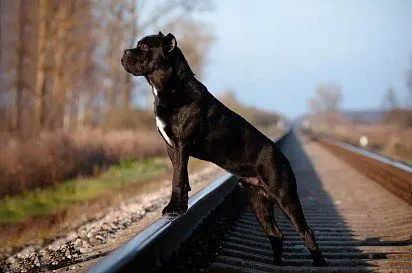
Cane Corso have an athletic build, appearance gives them uncompromising guards and real defenders. They look presentable and at the same time elegant: powerful body, broad chest, developed shoulders, muzzle typical of all Molossians, confident gait. Dogs of this breed are predominantly black, brown and brindle.
The character of the “Italian” consists of solid virtues: he is mentally balanced, predictable, easy to train, very devoted to his master and never shows unreasonable aggression. Such qualities are inherent in many representatives of the Molossian group, for example, the English Bulldog and the Dogue de Bordeaux. If bad traits began to appear in the behavior of the dog, the cause should be sought in poor education, but not in any way in a natural predisposition.
Head
The Cane Corso’s head is broad rather than long. Covered with dense skin, there are no folds on the muzzle. The muzzle, in turn, corresponds to the skull in a ratio of 1:2, that is, it is short. But at the same time, it is wide and voluminous, square in shape, flat and strong.
Teeth
A dog of this breed has 42 teeth, they are white and strong. The jaws are large, powerful, curved. Due to the fact that the lower jaw protrudes somewhat forward, the bite is characterized as a slight undershot bite.
Eyes
Oval in shape, have a wide arrangement on the muzzle. Their color depends on the color of the dog, but the darker it is, the better. Eyelids have black pigmentation.
Ears
By nature, the Cane Corso’s ears are slightly large and set wide apart, set close to the head. Covered with smooth and shiny hair, they, tapering towards the ends, hang down, adjacent to the dog’s cheeks. They can be stopped by giving the shape of an equilateral triangle.
Nose and lips
The nose is black and large, the nostrils are wide open. The lips are tight and not too droopy. The upper lips cover the lower jaw, thus completely defining the lower part of the muzzle profile.
Neck
The Cane Corso’s neck is strong, muscular, in proportion to the body, but not too bulky, giving the dog a certain elegance. Its length is equal to the length of the head.
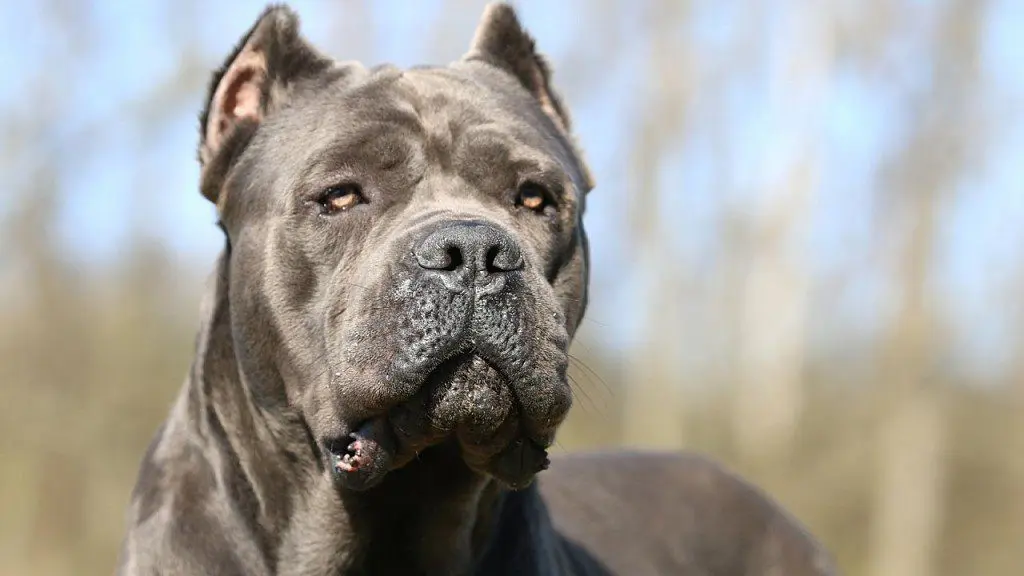
Frame
The constitution of the Cane Corso is strong, the body is somewhat longer in comparison with the height at the withers. The withers are pronounced, it protrudes above the long, wide and somewhat sloping croup. The chest reaches the level of the elbows, it is wide and well developed. The back is straight, has a pronounced muscularity. The convexity of the ribs is moderate.
Tail
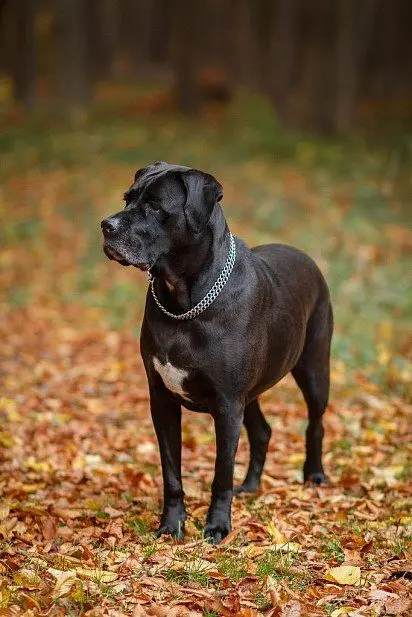
The tail of the Cane Corso is naturally long and reaches to the hocks, it is set high and thick at the base. Vertically does not rise and does not bend. Docking of the tail is done at the fourth vertebra.
limbs
The forelimbs are characterized by long, sloping and very developed shoulder blades. The shoulders and forearms are strong, the metacarpus and wrist are elastic. The front paws are of a cat type with elastic pads and strong claws. The paws are oval in shape, the fingers are collected in a ball.
The hind limbs are wide and long in the thigh, the back line of the thighs is convex. Strong lower legs and slightly angular hocks. Powerful and sinewy metatarsus. The hind feet are also oval, with elastic pads and strong claws, the fingers are gathered in a lump.
Thanks to these characteristics, Cane Corso move with a wide stride, they have a large and sweeping trot.
Wool
The skin is thick and close to the body. The coat of the Cane Corso is very thick, but with a sparse undercoat, short and shiny. If it is of medium length, devoid of stiffness and wavy, then this refers to the serious shortcomings of the breed.
Color
Here the breed standard allows for considerable variation. In addition to the traditional black, light red, dark red and brindle colors, Cane Corso can be light gray, lead (medium gray) and slate (dark gray), as well as red (fawn). Small white blotches are allowed, but only on the chest, nose and ends of the paws.
Note: Red and Brindle Cane Corso must have a black or gray mask on the muzzle, not extending beyond the line of the eyes.
Possible vices
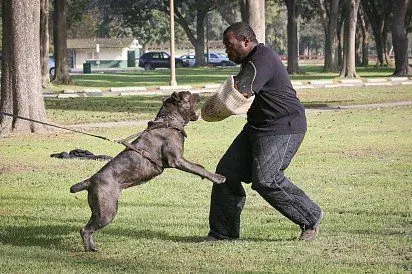
If the longitudinal axes of the muzzle and skull, as well as the lateral surfaces of the muzzle, converge, this is considered a serious defect. This also includes the parallel arrangement of the longitudinal axes of the muzzle and skull.
Shortcomings that spoil the breed include, among other things, growth below or above the norm, partial depigmentation of the nose, movements constantly turning into amble, scissor bite, tail curled or standing upright, undershot bite with significant waste.
Disqualifying vices
Is your pet aggressive? This is a serious vice, for which he will face disqualification. The same verdict will be passed on a fearful or frankly cowardly animal.
In general, any Italian Mastiff in which behavioral or physiological abnormalities are very clearly expressed should be disqualified. These also include undershot bite, the so-called mutton nose, sunken bridge of the nose, strabismus, an eyesore, fragmentary or complete depigmentation of the eyelids, long or soft hair, with unacceptable color and large white spots.
A sign of the health of the Cane Corso is the developed testicles of males. There are two of them, and they should be fully descended into the scrotum.
Photos cane corso
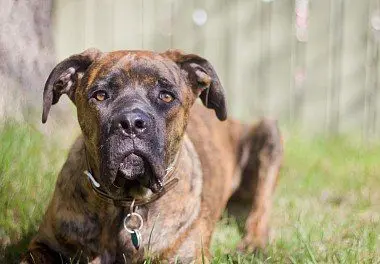
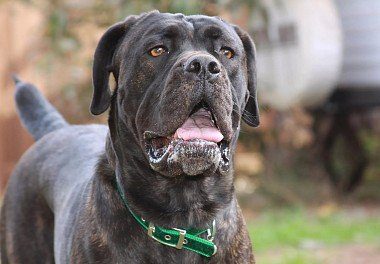
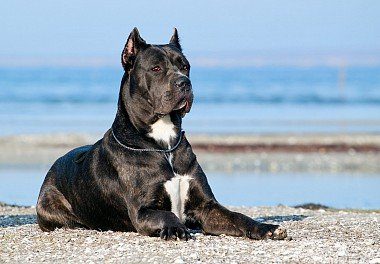
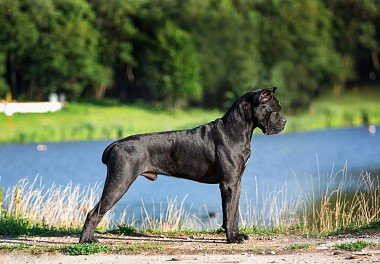
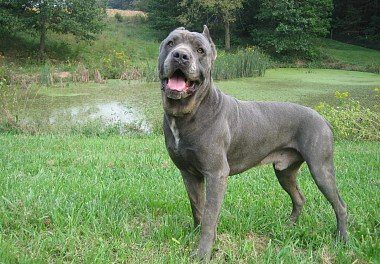

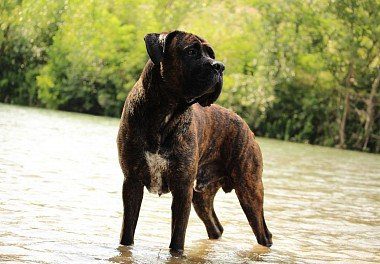
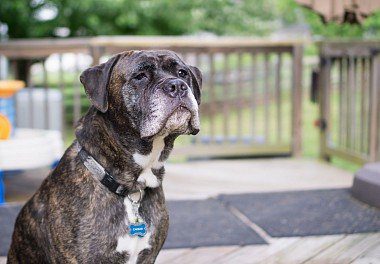
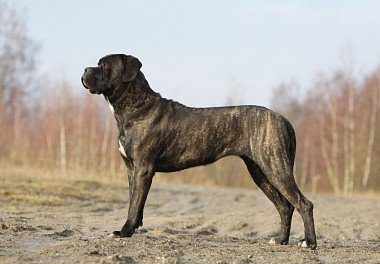
The nature of the Cane Corso
Only those who do not know the breed at all or judge it by its rather formidable appearance can speak critically or cautiously about these beautiful, intelligent “Italians”. And people who know speak of the Cane Corso exclusively positively, because you cannot find a more devoted, kind and good friend.
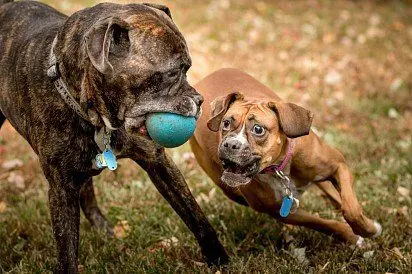
Among all other breeds, these natives of the Italian “boot” are called the golden mean, and there are many reasons for this. Cane Corsos are not giants, but at the same time they are not too small. They are always taut, and in order for your dog to always keep a good shape, his physical development needs to be given considerable attention. These dogs are naturally very intelligent and easy to train. The main condition is the right approach. Many owners are not confident in their teaching abilities, so they turn to professional cynologists.
The Cane Corso does look a little stern, so if you walk around the city with him, then a lot of passers-by will probably want to go to the other side of the street. It is difficult for ignorant people to imagine that a kind, affectionate and understanding creature is hiding behind the mask of a ferocious beast. Remember: sudden aggression in these dogs is absolutely not inherent. However, they do not let out of sight the people near whom the owner is located, and watch how he communicates with them.
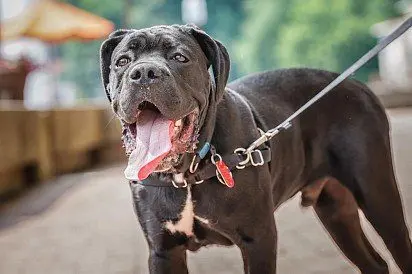
Cane Corsos are very playful and readily join in any entertainment. This playfulness is especially evident at a young age. Sometimes the dog is so passionate about the game that sometimes it does not respond to the owner’s command, which is quite forgivable – well, who doesn’t! As they grow older, Italian mastiffs become calm and measured. By nature, dogs are not at all selfish. There is no such trait as jealousy in them.
If the Cane Corso is so good-natured, playful, non-aggressive, then how are protective qualities combined with all these features? Very harmonious and one does not interfere with the other. They react quickly to danger, almost lightning fast. Strong jaws provide an iron grip, so that a thief who has entered your home will not be greeted when he meets this dog. In relation to uninvited guests, whom he perceives as violators of his territory, the dog can begin to act at its own discretion, sometimes not even obeying the owners.
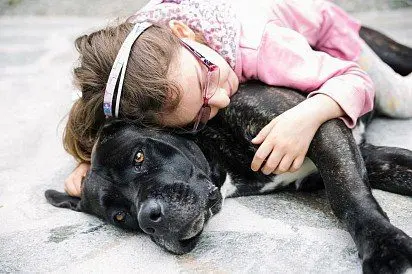
For the sake of its owners, Corso is ready for anything. In the presence of this dog, strangers should refrain from sudden movements. No, she will not immediately pounce on you, but with facial expressions she will show that it is not worth continuing. And a representative of this breed will never take anything from the hands of an outsider, including goodies. It is almost impossible to distract him from the protection of the owner, members of his family or any object that is part of his territory. These dogs perfectly understand who is theirs and who is a stranger. Sometimes it even seems that by some miracle, they can intuitively predict the evil intentions of a person before he starts to show them, that is, the sense of danger in these dogs is excellently developed. The Mastiff can begin to act long before the danger begins to really threaten his owners, trying in every possible way to warn them. Looking into the eyes of this smart dog is like reading her mind. If the Cane Corso could speak, then the best interlocutor, probably, would not be found.
Many wealthy people get a dog of this breed for prestige (after all, Corso is expensive), not particularly perceiving it as a full member of the family. For example, they can leave for a long time, leaving the dog in someone’s care. You can’t do this, because separation, and even more so betrayal, these dogs endure extremely painfully. In the absence of the owner, the “Italian” can become sad, stop eating and simply die. A real owner who treats his pet with love will show him all his love in every possible way and will never leave him alone for a long time.
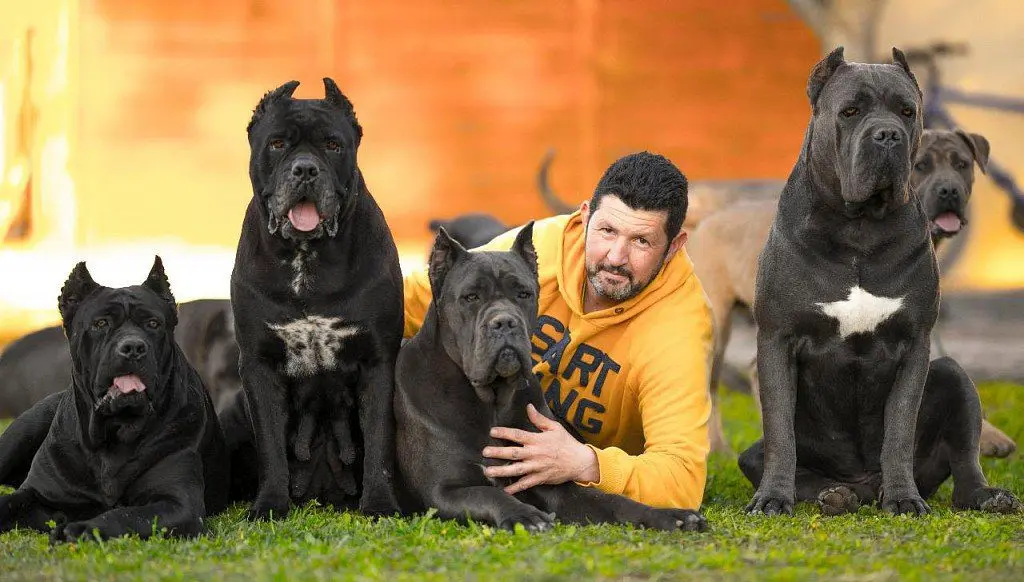
Training and education
The tendency to dominate is not in the character of the Cane Corso, which means that they are easy to train. Being complaisant by nature and naturally devoted to the owner, they recognize the authority of the latter very quickly. But representatives of this breed are in no hurry to grow up.

Many owners, for various reasons, do not want to use the services of cynologists (for example, because of the high cost of their services) and prefer to raise puppies on their own. What should you pay attention to in this case?
The process of raising a Cane Corso puppy should begin from the very first day of his appearance in the house. First of all, teach your baby to elementary cleanliness and toilet. The most necessary commands are: “Come to me!”, “Fu!”, “Sit!”, “Next!”, “Stand!”, “Lie down!”, “Place!”. They should train their pet first. If you don’t like something in the puppy’s behavior, try to correct it, preferably in the early stages. Disobedience should not result in physical punishment. Walking with him in the park or outside the city, fill your leisure time with any kind of sports training.
Dog training should take place on an empty stomach. This will stimulate her to accurately follow all the commands in order to receive a reward – a delicious treat. Do not forget to also praise your pet, which will be an additional expression of your love for him.
For your information: strangers should not take part in the upbringing of the Cane Corso. All commands must be pronounced clearly and understandably. Be consistent in training, require your pet to complete all the tasks assigned to him.
Care and maintenance
It is believed that even small dogs, not to mention more or less large ones, can create inconvenience for their owners in an ordinary city apartment. Cane Corso completely refute this stereotype. Despite the fact that they are not small dogs, they do not need a large space due to their inactivity. If you live in a private house, this does not mean at all that you can put your pet in a booth and put it on a chain. By their nature, the “Italians” are too freedom-loving and need to be constantly near the owner. In addition, the dog’s light undercoat is not able to warm it in severe frosts, so there is still no way to be a Cane Corso “yard dweller”.
Care and maintenance
It is believed that even small dogs, not to mention more or less large ones, can create inconvenience for their owners in an ordinary city apartment. Cane Corso completely refute this stereotype. Despite the fact that they are not small dogs, they do not need a large space due to their inactivity. If you live in a private house, this does not mean at all that you can put your pet in a booth and put it on a chain. By their nature, the “Italians” are too freedom-loving and need to be constantly near the owner. In addition, the dog’s light undercoat is not able to warm it in severe frosts, so there is still no way to be a Cane Corso “yard dweller”.
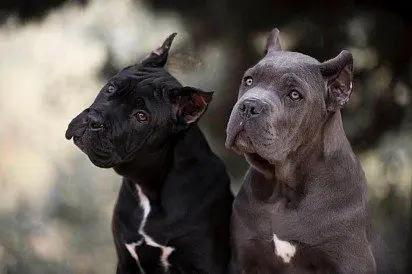
You should regularly walk with your pet, do not deprive him of the joy of outdoor activities. Going out with the dog outside the household and thereby changing the environment, you bring the necessary variety into her life, which has a positive effect on the nervous system, helps her not to weaken. At the same time, joint walks strengthen the mutual understanding of the owner and his four-legged friend. You should walk your dog for at least an hour at least twice a day. Cane Corso Italianos, like their counterparts in other large breeds, are prone to diseases of the musculoskeletal system. If your pet is less than two years old, don’t stress him out with long runs, let alone high hurdles.
Everyday care of the dog will not be difficult for you, and all thanks to his short coat and fine undercoat. It molts twice a year, in spring and autumn, and the whole process is almost invisible. I am also glad that the smell of dog does not spread from Corso around the house. True, he drools, which worries the owners. For such cases, you need to have a towel on hand.
It is enough to comb the dog once or twice a week, using a rubber comb or massage mitt. This will help not only remove dead hair, but also improve blood circulation. During the period of seasonal molting, it is recommended to comb it daily. When bathing your pet, use a rubber glove, which will also help get rid of dead hair faster. The coat of the dog has a protective fatty film, and if the Corso is often bathed using various detergents, the film will be washed off and the coat will fade. Bathing procedures should be arranged for dogs once a month or as they are heavily soiled. Experienced breeders recommend regular dry brushing. For this purpose, special dry shampoos are used. You can buy them at any pet store.
The dog’s ears need regular inspection so as not to miss the onset of a possible inflammation. They also need ventilation. Grasp the hanging ends with your fingers and wave your ears like butterfly wings. Cane Corso’s healthy ears do not have excess sulfur, brown discharge and, accordingly, unpleasant odors. To remove accumulated dirt, use a dry cotton pad, without penetrating deep into the ear canal. In the presence of purulent or other discharge, be sure to contact your veterinarian.
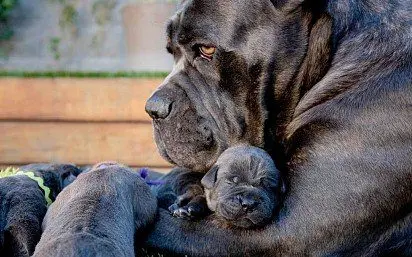
No less attention should be paid to the pet’s teeth. To keep them healthy for many years, do not let him gnaw on excessively hard objects, and even more so stones. Special treats and rope toys are used for brushing teeth. On the surface of the latter, agents that remove plaque are applied. But only a veterinarian can remove tartar. To prevent stone formation, the dog’s teeth should be brushed three to four times a week, using a special toothpaste with the function of dissolving the deposits that form the stone.
The eyes also need regular check-ups. In a healthy dog, the organs of vision are shiny, devoid of lacrimal ducts and secretions. Rinse the Cane Corso’s eyes periodically with chamomile decoction to prevent souring. To wipe the eyes, use a damp, lint-free cloth, and wipe each with a separate piece.
After walking, wipe your pet’s paws with a damp cloth or wash them in the shower. Pay attention to the paw pads, which will help to detect cracks or wounds in a timely manner. An antiseptic is used to treat them. As a prevention of cracks, ordinary vegetable oil is used. It is given to the dog in a teaspoon per day, and is also regularly rubbed into the paw pads.
And, of course, do not forget about ticks and fleas, which can cause great harm to the health and life of your Cane Corso. However, “amateur” in this important issue should not be dealt with. A remedy for ectoparasites should be selected by a veterinarian based on the age of the dog, its weight and health. A schedule for the treatment of the dog with the selected drug should be drawn up, which should be strictly adhered to.
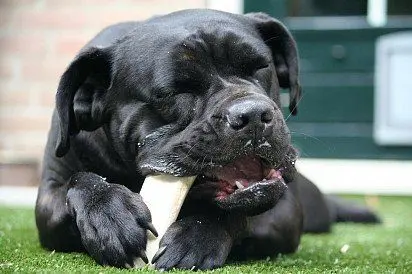
Now about feeding the dog. You can give her both natural products and ready-made food, but only premium. The main advantage of ready-made food is that it saves time, but is expensive. High-quality products are also not cheap, and besides, you have to spend time preparing them. But on the other hand, in the process of cooking, you see what exactly the diet of the Cane Corso is made up of, which cannot be said about ready-made feeds. Each type of feeding has its pros and cons, and which one is right for your pet is up to you. The main thing is that the well-being and health of your dog does not suffer from this.
Important: Cane Corso dogs are not recommended to give fatty meats (for example, pork), smoked meats, spicy foods, river fish, fatty dairy products (sour cream, cottage cheese, cream), some cereals (millet and pearl barley due to their poor digestibility) , fatty broths and thin soups. The same list includes various sweets, nuts, onions, garlic and cheap low-grade feed.
Health and disease of the Cane Corso
Cane Corso Italiano is the embodiment of strength and endurance and, it would seem, he cannot have any diseases. However, it is not. Representatives of this breed suffer from a number of hereditary ailments, the most common of which can be called hip dysplasia. This disease is practically not amenable to treatment, and in some cases, sadly, the dog has to be euthanized. There is a hereditary predisposition to this disease, but even experienced breeders often cannot recognize it in a puppy. Before buying a puppy, you can ask if he was x-rayed, which, however, does not completely insure against illness. For a greater guarantee, you should purchase an already grown puppy. Its cost will be much higher, but it will pay off with a minimal risk of developing hereditary diseases.
In addition to hip dysplasia, representatives of the breed may suffer from various types of allergies, bloating, cherry eye, epilepsy, thyroid diseases (hyperthyroidism), eyelid diseases (their eversion or inversion).
How to choose a puppy
Before making a choice, study the breed standard. It would be useful to visit mono-exhibitions: this will allow you to learn about Cane Corso, as they say, firsthand and choose the puppy’s parents. Be sure to look at the exterior and behavior of the mother. For whatever purpose you purchase a puppy, buy it not from your hands, but from breeders or in a kennel. This will allow you to be calm about the purity of the breed, the physical and mental health of the pet. The kid should be well-fed, very active. Ask the breeder about the character of your chosen puppy, ask him to focus on the features of his behavior. When buying, you must be given a veterinary passport.
Pictures of Cane Corso puppies
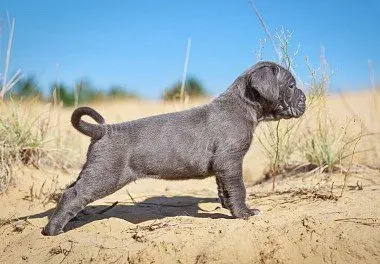
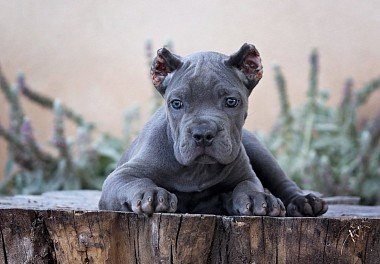
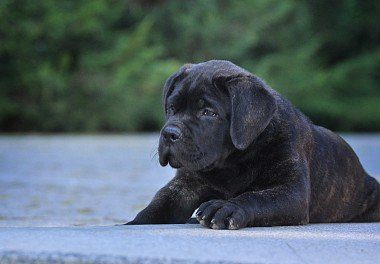
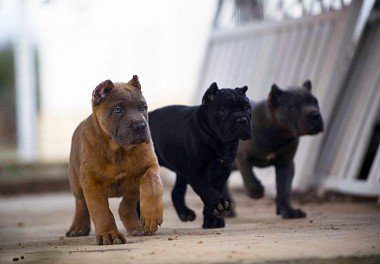
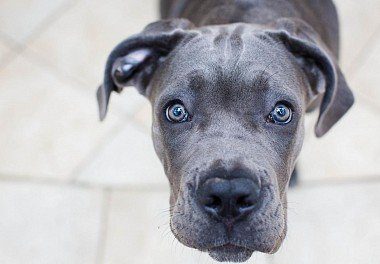
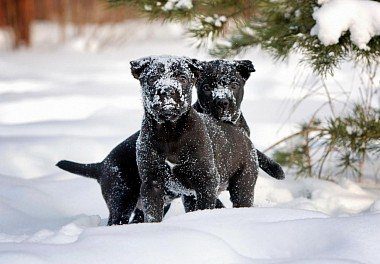
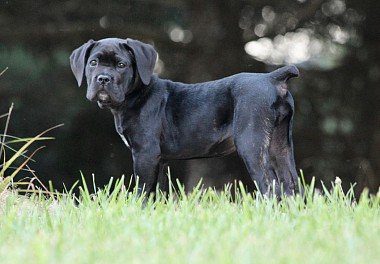
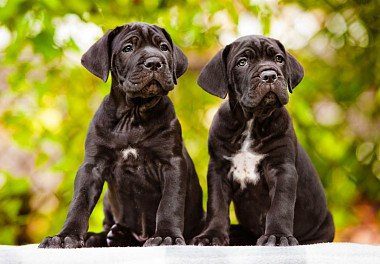
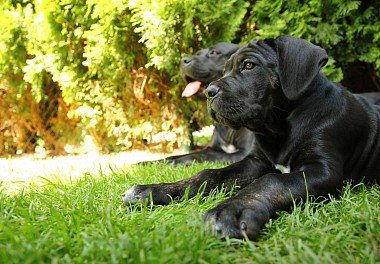
How much does a Cane Corso cost?
The cost of a Cane Corso varies from 150-200 to 800-1000 dollars. You can also count on “price” luck in large cities. This does not mean that a “mestizo” or “cors-like” dog will be slipped on you cheaply, but a low price does not guarantee the mental and physical health of even a genuine representative of the breed. In addition, you will get it without documents and vaccinations.
Hence the simple conclusion: you should buy a Cane Corso in nurseries or from elite breeders with an impeccable reputation. A healthy puppy with a deviation from the standard (pet class) can be purchased for 700-900 dollars. A breed-class puppy (breeding use) costs between $900 and $1,300. Well, a representative of the show class, that is, a puppy with the makings of a champion to participate in exhibitions, will be sold to you for 1300-2000 dollars. For comparison: the average price from breeders in Moscow is 1000 dollars and more. Experienced owners recommend: it is better to pay this money than to save money, but then suffer for many years trying to re-educate the dog or running with it to the veterinarians.



